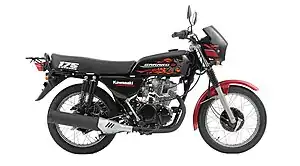Kawasaki Barako
The Kawasaki Barako is a motorcycle model built by Kawasaki Motors Philippines and launched in 2004. The Kawasaki Barako was designed to replace the older two-stroke Kawasaki HD-III which was launched in 1982 until it was phased out in 2007. The BC 175 is primarily used as utility hauler for business needs.
 Kawasaki Barako II 2023 Model. | |
| Manufacturer | Kawasaki Motors Philippines |
|---|---|
| Production | 2004–present |
| Predecessor | Kawasaki HD-III 125cc |
| Class | Standard |
| Engine | 177 cc, 4-stroke, SOHC, single-cylinder engine, Secondary air injection |
| Transmission | 4-speed manual clutch; Chain-drive |
| Suspension | Front: Telescopic fork Rear: Swing arm |
| Brakes | Front: Drum brake Rear: Drum brake |
| Tires | Front: 3.00mm x 17mm Rear: 3.00mm x 17mm |
| Dimensions | L: 2010 (mm) W: 805 (mm) H: 1070 (mm) |
| Fuel capacity | 12 L |
Background
It was initially launched as the Kawasaki Barako 175 with an engine that originally came from the Eliminator,[1] but with the implementation of stricter emissions regulations and an extremely competitive market, an enhanced version, the Kawasaki Barako II 175, was later launched.
There are two variants available in the market in which differs on how the motorcycle is started: a standard Barako with only a kick start and a higher variant of Barako both equipped with a kick start and an electric starter.
The engine of the Kawasaki Barako is also used on the Kawasaki W175 leisure bike, albeit with a different transmission setup and the lack of a kick starter.
Features
The product was known for its capability to carry heavier loads due to its 177 cc displacement. Its four stroke engine is suited for utility and business use. The engine for the later model, Barako II, was tweaked to produce up to 15% more power and to be up to 13% more fuel efficient than the earlier versions of Barako, and it maintains fuel efficiency of up to 57 km per liter.[2]
Like other utility motorcycles, the Barako series has a long seat was placed behind the fuel tank to accommodate extra passenger. The frame was also modified for its future use for sidecar operation. It is equipped with Kawasaki Automatic Compression Release (KACR), which makes kick starting much easier and reduces rider pressure, ensuring a smooth operation.[2]
The utilization of a Secondary Air System (SAS) enables the Barako series to initially pass Euro 2 emissions regulation which has been since upgraded to Euro III emissions regulation.[3]
In 2017, the Barako II has since been equipped with Fuel Gauge which is absent in earlier models. And recently, its overall appearance was overhauled to give an improved sporty look. The brakes and the drivetrain was painted black and its chrome tailpipe was replaced with racing-inspired muffler.[3]
References
- "Malaysian building turbocharged Kawasaki Barako - Motorcycle News". MotoPinas.com. April 27, 2020. Retrieved October 23, 2023.
- "Lakas ng Barako, puso ng Pinoy Kawasaki unleashes Barako II". Philstar.com. Retrieved October 23, 2023.
- "Barako II". Kawasaki Motors (Phils.) Corporation.